Dashi is a drawer
Dashi is a drawer
Bring out a variety of flavors
Japanese cuisine is about subtraction
So I'll draw it out modestly.
Bring out a variety of flavors
Japanese cuisine is about subtraction
So I'll draw it out modestly.
▲From the left, the books are "Vegetable Stock," "Everyday Side Dishes with Dried Anchovies from Setouchi's "Yamakuni," "Nozaki Hiromitsu's Rules for Deliciousness," and "Marumoto Yoshio's Systematic Cooking Theory."
The products are "dried anchovies" and "crispy roasted dried anchovies."
We would like to introduce these four books and two products.
●The reason why "Dashi is not necessary. Water is enough"
First, we would like to introduce a book by Nozaki Hiromitsu, executive chef of Waketokuyama in Minami-Azabu.
This book can be considered a compilation of the chef's previous publications.
◎ "Hiromitsu Nozaki's Rules for Deliciousness"
(Author: Hiromitsu Nozaki, Published by Ikeda Shoten, 1,600 yen (excluding tax))
"Cooking is easy. Even a third grader can do it," writes the author.
"There is nothing as simple as Japanese dashi stock," he said.
We introduce "Dashi stock made with bonito and kelp using hot water from a pot" and "Dashi stock made with dried sardines that can be made by simply soaking them in water."
The products are "dried anchovies" and "crispy roasted dried anchovies."
We would like to introduce these four books and two products.
●The reason why "Dashi is not necessary. Water is enough"
First, we would like to introduce a book by Nozaki Hiromitsu, executive chef of Waketokuyama in Minami-Azabu.
This book can be considered a compilation of the chef's previous publications.
◎ "Hiromitsu Nozaki's Rules for Deliciousness"
(Author: Hiromitsu Nozaki, Published by Ikeda Shoten, 1,600 yen (excluding tax))
"Cooking is easy. Even a third grader can do it," writes the author.
"There is nothing as simple as Japanese dashi stock," he said.
We introduce "Dashi stock made with bonito and kelp using hot water from a pot" and "Dashi stock made with dried sardines that can be made by simply soaking them in water."

▲ Strained "bonito and kelp stock made with hot water from a pot" (left) and dried sardines pulled out of "dried sardine stock made by simply soaking them" (right).
Making dried sardine stock is especially easy; just put dried sardines in water and leave for 2 to 3 hours!
It even says, "If you want a more refined flavor, you can remove the heads and organs from the dried sardines, but you can also leave them whole."
The author also says, "You don't need dashi; water is enough."
The reason is that if the ingredients in a stew or miso soup have umami, water is enough.
If it lacks umami flavor, you can just add dashi to make up for it.
The easiest way is to make cold dashi.
Just like dried sardines, all you have to do is put kelp in water and put it in the refrigerator.
However, it is best to use it within 2-3 hours and 24-48 hours (for taste and safety).
 ▲ Just add 3g of dried sardines (about 2 large 8-10cm sardines) to the left bottle, and 1-2g of kelp (1-2cm cubes) to the right bottle, with 150cc of water each. (Each bottle is for one person, must be kept refrigerated.)
▲ Just add 3g of dried sardines (about 2 large 8-10cm sardines) to the left bottle, and 1-2g of kelp (1-2cm cubes) to the right bottle, with 150cc of water each. (Each bottle is for one person, must be kept refrigerated.)
If the stock is too thick, add water.
Chef Nozaki also writes, "In such cases," "add water."
● Dried sardines are the same as dried sardines
It is mainly called "niboshi" in the Kanto region and "iriko" in the Kansai region.
It is made from boiled and dried young anchovy fish.
In other words, "iriko" and "niboshi" are the same thing.
We would like to introduce you to a rare recipe book using dried sardines.
◎ "Daily side dishes using dried sardines from Setouchi's "Yamakuni""
(Written by Maki Watanabe, published by the Japan Women's University Press, 1,200 yen (excluding tax))
Author Watanabe Maki wanted people to be able to enjoy the "profound flavor of dried sardines" at home, so she compiled an entire book of recipes using only dried sardines.
This book expands the infinite possibilities of dried sardines.
The cooking section of DAIKANYAMA TSUTAYA BOOKS also sells dried sardines from Yamakuni in the Setouchi region.
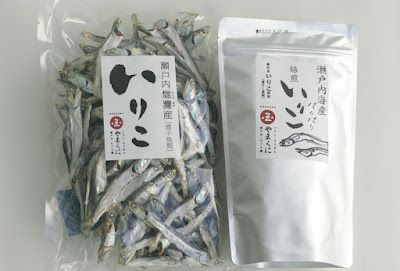
The dried sardines sold in the cooking corner of DAIKANYAMA TSUTAYA BOOKS are large, o-ba (8-10cm) in size, with two of them weighing about 3g.
150cc of water will make one small bowl of miso soup.
(Please also see the blog "Miso Soup LOVE" dated May 30, 2017.)
If you use 2 dried sardines and 150cc of water, one 200g bag will make about 66 cups of miso soup.
If you make two cups of soup stock a day, this product will last about a month.
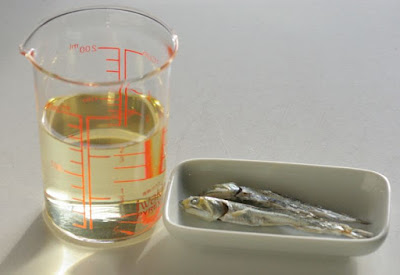
Dashi made from dried anchovies with the heads still on can be used without any problems in miso soup or soy sauce-flavored simmered dishes.
On the other hand, the "crispy roasted anchovies" have already had their innards and gills carefully removed by hand, and are roasted slowly over low heat until crispy.
It is a natural food with no added chemical seasonings.
This product requires no pre-processing, so you can use it straight away and save time.
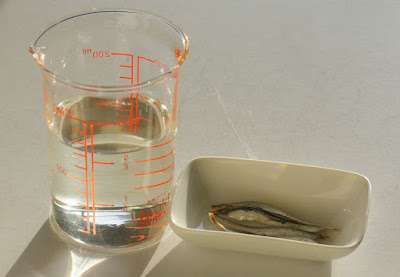
The soup stock made with pre-processed "crispy roasted dried sardines" has no fishy smell at all and is an elegant flavor.
The dashi stock, which the author named "Zeitaku Iriko Dashi," is "a luxurious stock that combines the umami flavor of dried sardines, 'inosinic acid,' with 'glutamic acid' from kelp and 'guanylic acid' from dried shiitake mushrooms."
 ▲ Dashi made with "Zeitaku Iriko Dashi" and three ingredients: kelp, dried sardines and dried shiitake mushrooms.
▲ Dashi made with "Zeitaku Iriko Dashi" and three ingredients: kelp, dried sardines and dried shiitake mushrooms.
(Here, we used dried sardines from Yamakuni in the Setouchi region, donko from Oita, and Rausu kelp.)
This soup stock alone is a nutritious dish.
● "Vegetable stock" made with kelp and vegetables
The next author, who says "simple and delicious can be achieved," runs a vegetable restaurant called "Narutoya + Tenzo" in Kamakura and also holds cooking classes.
We would like to introduce you to a book by an author who hopes that people will enjoy eating vegetables more enjoyably and deliciously.
◎ "Vegetable Stock"
(Author: Ichikawa Yosuke, Published by Shufu to Seikatsusha, 1,400 yen (excluding tax))
"All you need to make vegetable stock is vegetables, kelp, and water."
"You don't need bonito flakes or dried sardines," says the author.
"Learn about vegetable stock and make everyday meals easier."
"If it becomes easier, it will be fun to be in the kitchen."
"I put all my effort into creating this book."
Trust these words and make cooking easy.
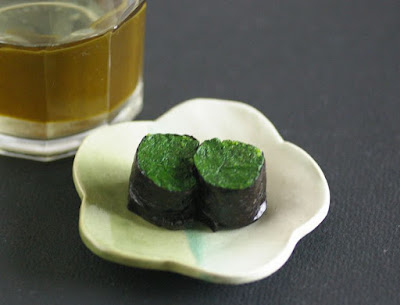 ▲I made a slightly modified version of the recipe for "Spinach Tossed with Roasted Seaweed" from the chapter "Vegetable Stock Made by Quickly Boiling Vegetables and Soaking in Kombu Water."
▲I made a slightly modified version of the recipe for "Spinach Tossed with Roasted Seaweed" from the chapter "Vegetable Stock Made by Quickly Boiling Vegetables and Soaking in Kombu Water."
Even a small dish, if made carefully,
It makes you feel like you've had a proper meal.
● Dried bonito flakes are the ultimate luxury
Finally, I would like to introduce a paperback reprint of a book written in April 1982.
◎ "Seisei Marumoto's Systematic Cooking Theory" (Chikuma Bunko)
(Author: Yoshio Marumoto, Published by Chikumashobo, 780 yen (excluding tax))
It became a best-seller when it was published and has since become a long-selling book.
After this book, the late Yoshio Marumoto published many books as a researcher of home cooking from the perspective of modern nutrition.
The afterword was written by her daughter, Kie Marumoto (chef).
Here is a quote from "Marumoto Yoshio's Simple Cooking" (published in 1993).
"I wrote that after the war, women were banished from shaving bonito flakes, but I realized that was a big mistake."
"It was the men who stopped sharpening their planes who were expelled."
Apparently, his father was "diligently taking care of his bonito shaving machine."
 ▲Katsuobushi shaving machines (home and portable), bonito flakes, and shaved bonito (all personal belongings of staff members).
▲Katsuobushi shaving machines (home and portable), bonito flakes, and shaved bonito (all personal belongings of staff members).
The surface of shaved bonito flakes is a beautiful ruby color, and when you stroke it it feels as smooth as marble.
Freshly shaved bonito flakes are a delicious treat in themselves.
The scent is completely different.
Just like grinding coffee beans, shaving your own bonito flakes makes you feel truly enriched.

This is the moment when you realize that bonito flakes are food!
●Chiffon cake with a large selection of dashi
Chef Nozaki, who we introduced first, writes in his aforementioned book that "both tomato juice and soy milk" can be used as stock.
These too have a certain "umami" flavor.
So I decided to make a chiffon cake and a rice pot dish using a lot of dashi.
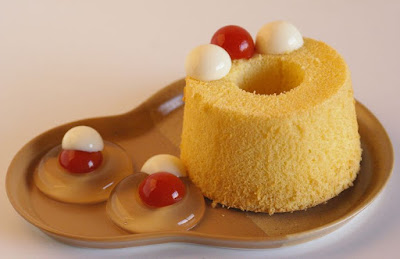 ▲ Dashi chiffon cake served with dashi, tomato juice and soy milk jelly (made with agar).
▲ Dashi chiffon cake served with dashi, tomato juice and soy milk jelly (made with agar).
The subtle sweetness of the rice flour and rice oil chiffon cake goes perfectly with the moist, savory jellies.

The rice with soybeans was cooked in dashi stock, and rice oil was used for the kelp, bonito flakes, and tamagoyaki.
Both are highly nutritious and nourishing.
It will satisfy both your stomach and your heart.
********************
[Recommended books]
1. "Hiromitsu Nozaki's Rules for Delicious Food"
(Author: Hiromitsu Nozaki, Published by Ikeda Shoten)
1,600 yen (excluding tax)

・Online store is here
2. "Daily side dishes made with dried sardines from Yamakuni in the Setouchi region"
(Author: Bemaki Watanabe, Published by the Japan Women's University Press)
1,200 yen (excluding tax)
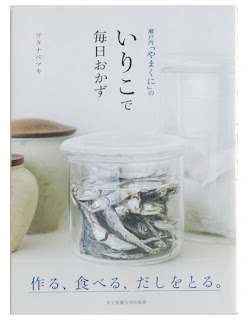
・Online store is here
3. "Vegetable Stock"
(Author: Yosuke Ichikawa, Published by Shufu to Seikatsusha)
1,400 yen (excluding tax)

・Online store is here
4. "Seisei Marumoto's System Cooking Theory" (Chikuma Bunko)
(Author, Yoshio Marumoto, Published by Chikuma Shobo)
780 yen (excluding tax)

・Online store is here
********************
Dashi is such an understated entity.
But it is full of rich nutrients,
It brings out the best in the ingredients, or harmonizes with them.
It seeps into your body.
Whether it's a simple dashi or a carefully made dashi, they are both high-quality products.
Feel free to pop in and have some fun.
Culinary Concierge
Sawa Mineko
Making dried sardine stock is especially easy; just put dried sardines in water and leave for 2 to 3 hours!
It even says, "If you want a more refined flavor, you can remove the heads and organs from the dried sardines, but you can also leave them whole."
The author also says, "You don't need dashi; water is enough."
The reason is that if the ingredients in a stew or miso soup have umami, water is enough.
If it lacks umami flavor, you can just add dashi to make up for it.
The easiest way is to make cold dashi.
Just like dried sardines, all you have to do is put kelp in water and put it in the refrigerator.
However, it is best to use it within 2-3 hours and 24-48 hours (for taste and safety).

If the stock is too thick, add water.
Chef Nozaki also writes, "In such cases," "add water."
● Dried sardines are the same as dried sardines
It is mainly called "niboshi" in the Kanto region and "iriko" in the Kansai region.
It is made from boiled and dried young anchovy fish.
In other words, "iriko" and "niboshi" are the same thing.
We would like to introduce you to a rare recipe book using dried sardines.
◎ "Daily side dishes using dried sardines from Setouchi's "Yamakuni""
(Written by Maki Watanabe, published by the Japan Women's University Press, 1,200 yen (excluding tax))
Author Watanabe Maki wanted people to be able to enjoy the "profound flavor of dried sardines" at home, so she compiled an entire book of recipes using only dried sardines.
This book expands the infinite possibilities of dried sardines.
The cooking section of DAIKANYAMA TSUTAYA BOOKS also sells dried sardines from Yamakuni in the Setouchi region.

▲ On the left is "iriko" (200g, 830 yen (excl. tax),
On the right is "Crispy Roasted Dried Anchovies" (70g, 830 yen (excl. tax)
The dried sardines sold in the cooking corner of DAIKANYAMA TSUTAYA BOOKS are large, o-ba (8-10cm) in size, with two of them weighing about 3g.
150cc of water will make one small bowl of miso soup.
(Please also see the blog "Miso Soup LOVE" dated May 30, 2017.)
If you use 2 dried sardines and 150cc of water, one 200g bag will make about 66 cups of miso soup.
If you make two cups of soup stock a day, this product will last about a month.

▲ Dashi made from dried sardines, and then dried sardines.
Dashi made from dried anchovies with the heads still on can be used without any problems in miso soup or soy sauce-flavored simmered dishes.
On the other hand, the "crispy roasted anchovies" have already had their innards and gills carefully removed by hand, and are roasted slowly over low heat until crispy.
It is a natural food with no added chemical seasonings.
This product requires no pre-processing, so you can use it straight away and save time.

▲ Dashi made with "crispy roasted dried sardines" and "crispy roasted dried sardines".
The soup stock made with pre-processed "crispy roasted dried sardines" has no fishy smell at all and is an elegant flavor.
The dashi stock, which the author named "Zeitaku Iriko Dashi," is "a luxurious stock that combines the umami flavor of dried sardines, 'inosinic acid,' with 'glutamic acid' from kelp and 'guanylic acid' from dried shiitake mushrooms."

(Here, we used dried sardines from Yamakuni in the Setouchi region, donko from Oita, and Rausu kelp.)
This soup stock alone is a nutritious dish.
● "Vegetable stock" made with kelp and vegetables
The next author, who says "simple and delicious can be achieved," runs a vegetable restaurant called "Narutoya + Tenzo" in Kamakura and also holds cooking classes.
We would like to introduce you to a book by an author who hopes that people will enjoy eating vegetables more enjoyably and deliciously.
◎ "Vegetable Stock"
(Author: Ichikawa Yosuke, Published by Shufu to Seikatsusha, 1,400 yen (excluding tax))
"All you need to make vegetable stock is vegetables, kelp, and water."
"You don't need bonito flakes or dried sardines," says the author.
"Learn about vegetable stock and make everyday meals easier."
"If it becomes easier, it will be fun to be in the kitchen."
"I put all my effort into creating this book."
Trust these words and make cooking easy.

Even a small dish, if made carefully,
It makes you feel like you've had a proper meal.
● Dried bonito flakes are the ultimate luxury
Finally, I would like to introduce a paperback reprint of a book written in April 1982.
◎ "Seisei Marumoto's Systematic Cooking Theory" (Chikuma Bunko)
(Author: Yoshio Marumoto, Published by Chikumashobo, 780 yen (excluding tax))
It became a best-seller when it was published and has since become a long-selling book.
After this book, the late Yoshio Marumoto published many books as a researcher of home cooking from the perspective of modern nutrition.
The afterword was written by her daughter, Kie Marumoto (chef).
Here is a quote from "Marumoto Yoshio's Simple Cooking" (published in 1993).
"I wrote that after the war, women were banished from shaving bonito flakes, but I realized that was a big mistake."
"It was the men who stopped sharpening their planes who were expelled."
Apparently, his father was "diligently taking care of his bonito shaving machine."

The surface of shaved bonito flakes is a beautiful ruby color, and when you stroke it it feels as smooth as marble.
Freshly shaved bonito flakes are a delicious treat in themselves.
The scent is completely different.
Just like grinding coffee beans, shaving your own bonito flakes makes you feel truly enriched.

▲Place freshly grated bonito flakes on the tofu.
This is the moment when you realize that bonito flakes are food!
●Chiffon cake with a large selection of dashi
Chef Nozaki, who we introduced first, writes in his aforementioned book that "both tomato juice and soy milk" can be used as stock.
These too have a certain "umami" flavor.
So I decided to make a chiffon cake and a rice pot dish using a lot of dashi.

The subtle sweetness of the rice flour and rice oil chiffon cake goes perfectly with the moist, savory jellies.

▲This rice pot is made with the same ingredients as chiffon cake.
The rice with soybeans was cooked in dashi stock, and rice oil was used for the kelp, bonito flakes, and tamagoyaki.
Both are highly nutritious and nourishing.
It will satisfy both your stomach and your heart.
********************
[Recommended books]
1. "Hiromitsu Nozaki's Rules for Delicious Food"
(Author: Hiromitsu Nozaki, Published by Ikeda Shoten)
1,600 yen (excluding tax)

・Online store is here
2. "Daily side dishes made with dried sardines from Yamakuni in the Setouchi region"
(Author: Bemaki Watanabe, Published by the Japan Women's University Press)
1,200 yen (excluding tax)

・Online store is here
3. "Vegetable Stock"
(Author: Yosuke Ichikawa, Published by Shufu to Seikatsusha)
1,400 yen (excluding tax)

・Online store is here
4. "Seisei Marumoto's System Cooking Theory" (Chikuma Bunko)
(Author, Yoshio Marumoto, Published by Chikuma Shobo)
780 yen (excluding tax)

・Online store is here
********************
Dashi is such an understated entity.
But it is full of rich nutrients,
It brings out the best in the ingredients, or harmonizes with them.
It seeps into your body.
Whether it's a simple dashi or a carefully made dashi, they are both high-quality products.
Feel free to pop in and have some fun.
Culinary Concierge
Sawa Mineko























